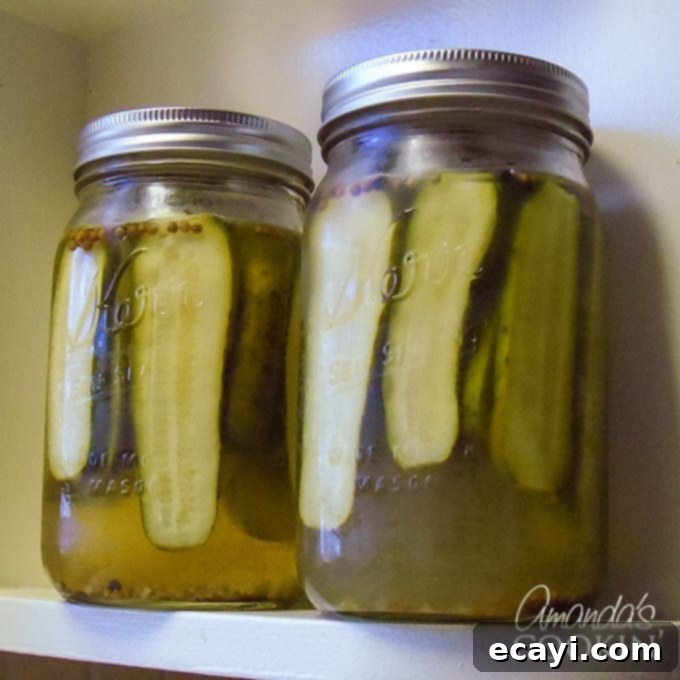Master the Art of Homemade Claussen-Style Refrigerator Dill Pickles: Your Ultimate Copycat Recipe Guide
For as long as I can remember, Claussen Kosher Dill Pickles have held a special place in my heart – and on my plate! I’ve never been a fan of sweet pickles, gherkins, or bread and butter varieties; they simply don’t offer that iconic, robust dill flavor and satisfying crunch that I crave. In my humble opinion, Claussen pickles consistently deliver superior taste and texture, far surpassing any shelf-stable dill pickles I’ve tried from the grocery store. Those often fall short, being either too sugary or overly acidic without the right balance. This deep-seated preference is precisely why, several years ago, I embarked on a journey to create and share this very Claussen copycat pickle recipe with fellow pickle enthusiasts.
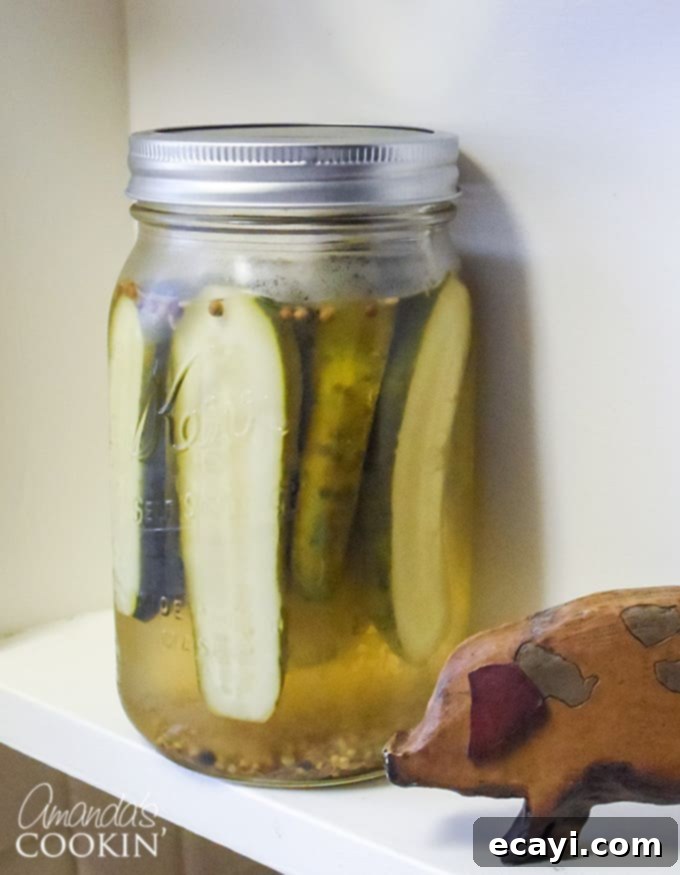
One of the primary reasons I love making this version of homemade pickles is that they are refrigerator pickles. This method is significantly less demanding than traditional canning, which often requires specialized equipment like pressure canners or large water bath canners, along with a meticulous multi-step sterilization process. With refrigerator pickles, you bypass all that complexity, making it an accessible and enjoyable culinary project for even novice home cooks. The trade-off, of course, is that these pickles cannot be stored on a shelf in your pantry or basement; they require constant refrigeration to maintain their freshness and safety. However, this also contributes to their signature crisp texture, a hallmark of excellent dill pickles.
Crafting Authentic Claussen Pickles at Home
My quest for the perfect dill pickle began after a somewhat disappointing experience with a canning recipe last year. The particular recipe I used featured an exceptionally high vinegar-to-water ratio. While the resulting pickles were certainly preserved, their overpowering vinegary taste made them unsuitable for eating straight from the jar – a favorite indulgence of mine! They were still quite good when sliced and added to burgers or mixed into a creamy potato salad, but they lacked the balanced, refreshing flavor profile of my beloved Claussen pickles. This experience solidified my resolve to find or create a recipe that truly captured that distinct Claussen essence, allowing me to enjoy them just as I would from the store, but with the added satisfaction of having made them myself.
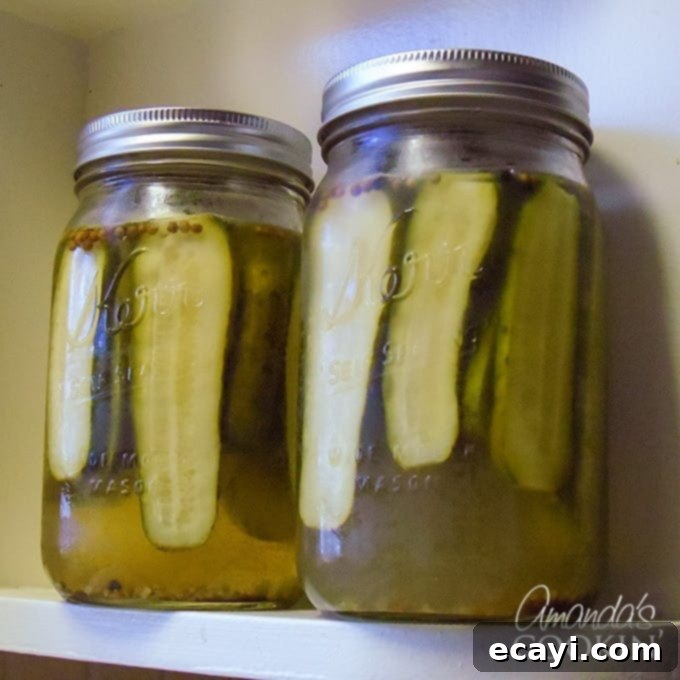
Thus began my dedicated search for a Claussen copycat pickle recipe. I scoured various culinary blogs and resources, eventually stumbling upon this promising option. However, a key ingredient gave me pause: apple cider vinegar. My concern was that apple cider vinegar, with its inherent fruitiness and subtle sweetness, might veer the flavor profile towards a sweet pickle, which is precisely what I aim to avoid. Even though the author of that particular recipe shared my aversion to sweet pickles, I was hesitant to risk compromising the pure dill taste. To ensure authenticity, I took a direct approach: I examined an actual Claussen ingredient label. The label clearly stated that they use distilled white vinegar. Armed with this crucial piece of information and noting other ingredient differences, I decided to use the existing recipe as a foundational starting point, then meticulously adapted and refined it to develop my very own version, tailored to replicate the classic Claussen flavor.
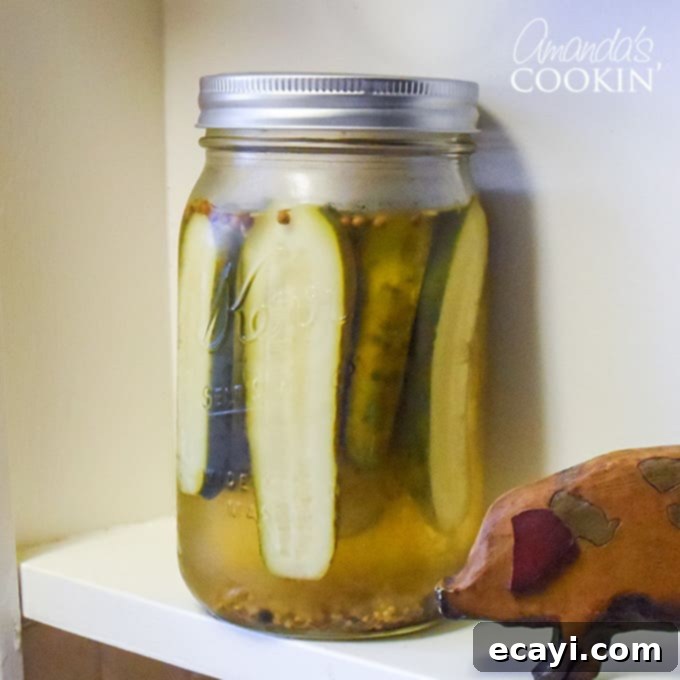
The verdict? These homemade Claussen copycat pickles are a resounding success! Everyone in my household absolutely loves them. While they may not be an *exact* clone of the original Claussen, they come incredibly close – close enough, in fact, that they are consistently devoured with enthusiasm. The satisfaction of crafting something so delicious from scratch, something that brings joy to my family, is truly rewarding. It’s certainly easier to simply grab a jar of Claussen from the grocery store, and I still might occasionally, but the process of making my own has become a genuinely enjoyable and fulfilling culinary endeavor.
My initial batch, while tasty, presented a couple of minor imperfections: they were a bit cloudy and had a more pronounced mustard flavor than desired. Learning from this, I adjusted the amount of mustard seed in the second batch. This small but significant tweak made all the difference, resulting in a cleaner flavor and a clearer brine. I’m confident we now have a winning homemade Claussen dill pickle recipe that consistently delivers that coveted crunch and tangy dill goodness!
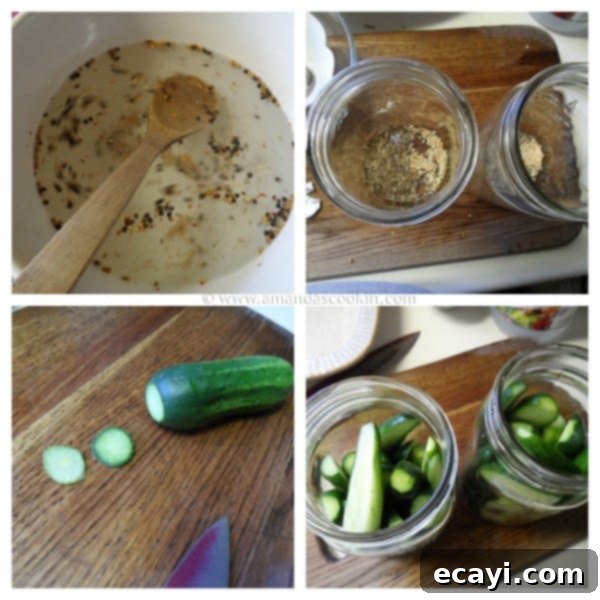
To begin your journey to homemade pickle perfection, you’ll first prepare the brine. For optimal ease and efficiency, I highly recommend mixing the brine directly in a 2-quart pitcher. While the picture above might show me mixing in a bowl, trust me, a pitcher simplifies both the stirring and pouring steps, saving you effort and an extra dirty dish. Once your brine is prepared, add the dill seed and dried garlic directly into your clean pickling jars.
Next, meticulously prepare your pickling cucumbers. Begin by giving them a thorough rinse under cold water to ensure all dirt and debris are removed. This crucial step contributes to the cleanliness and safety of your final product. After washing, it’s essential to trim the blossom end of each cucumber; this end contains an enzyme called pectinase, which can cause your pickles to turn soft and mushy. For good measure and to maintain uniformity in shape, I typically trim a small sliver off both ends of the cucumber. Finally, cut each cucumber in half lengthwise and carefully arrange them in your prepared jars, fitting as many as you can snugly without crushing them. A tight pack helps keep the cucumbers submerged in the brine.
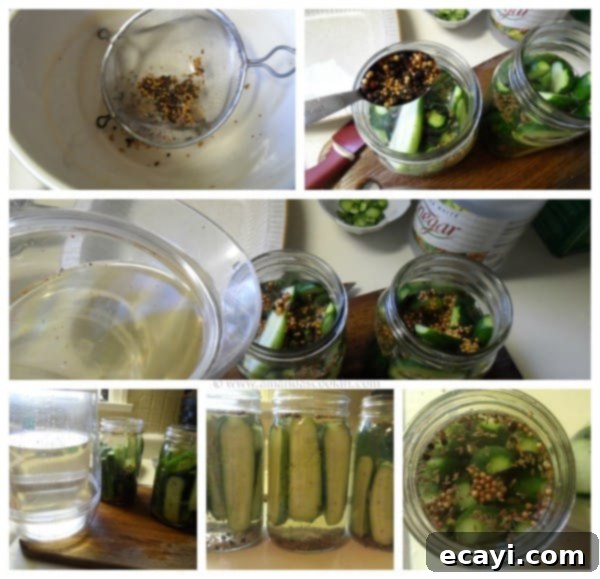
Before you add your prepared brine to the jars, an important step is to strain out the solid spices. This ensures an even distribution of flavor and prevents all the spices from settling at the bottom of just one jar. Place a fine mesh colander over a large bowl or measuring cup, then pour the brine through, catching the brine solids in the colander. Do not discard these solids! Instead, distribute them evenly among your two jars, then pour the strained brine liquid over the cucumbers until they are fully submerged. You will likely have some leftover brine, which can be discarded once you are finished filling the jars.
When placing the lid on your jars, it’s critical not to seal them tightly. Instead, simply “perch” the lid lightly on top. This allows for proper air circulation, enabling gases produced during the fermentation process to escape, which is vital for safe and successful pickling. A tightly sealed jar could build up pressure and potentially compromise the fermentation.
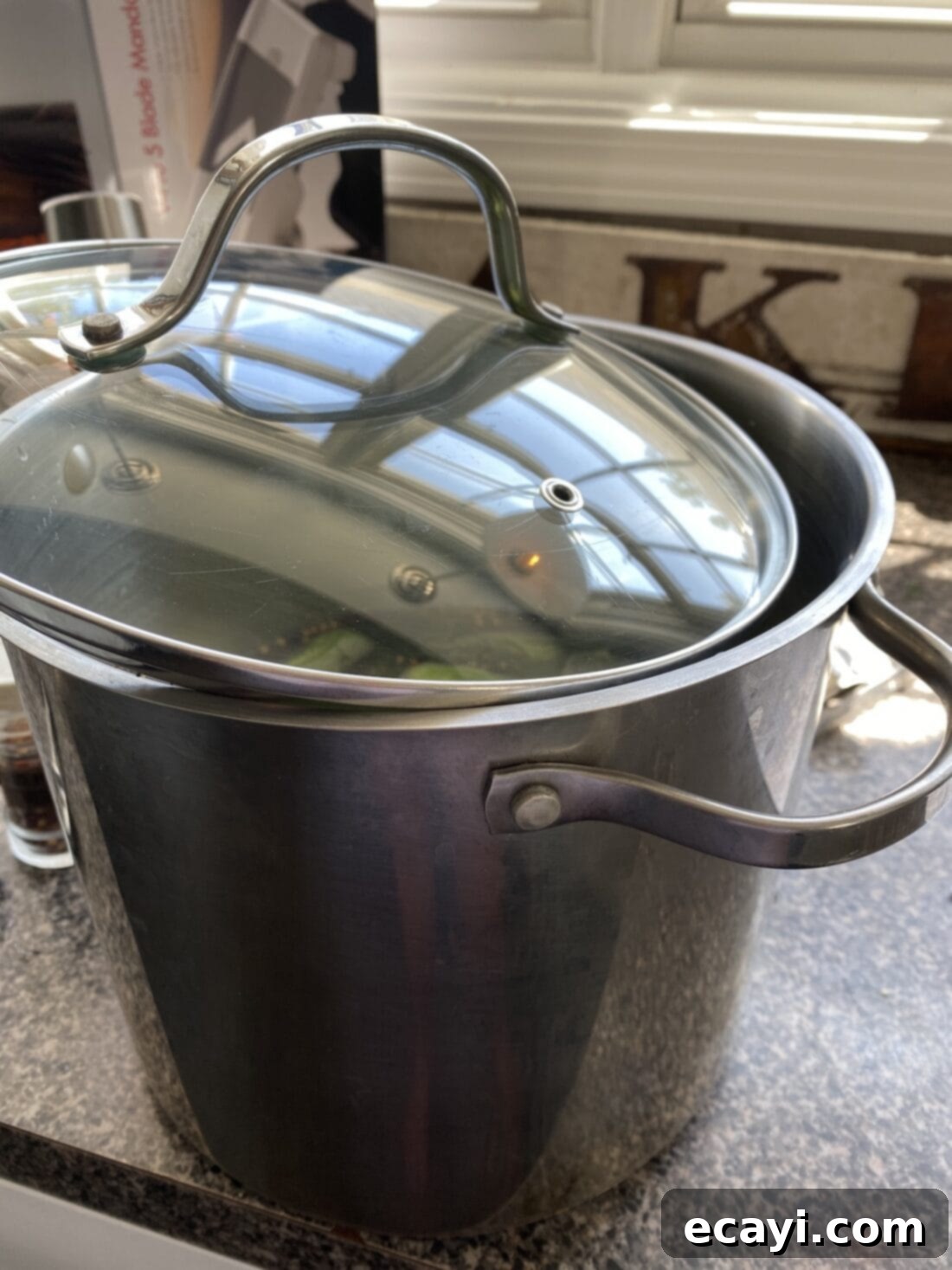
As a practical tip, I’ve found that instead of multiple jars, I sometimes prefer to initiate the pickling process in one large pot, especially for bigger batches. Once the initial fermentation period is complete, I then transfer the pickles and brine to a large covered glass container for refrigeration. For those who might have wondered what “perching the lid” looks like, the image above provides a clear visual example of how to cover your container loosely, allowing necessary airflow.
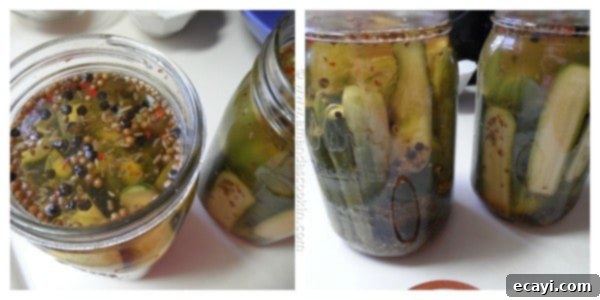
After just a day or so on the counter, your cucumbers will begin to transform, taking on the characteristic color and scent of pickles. The full transformation typically takes between 2 to 4 days, depending on various factors. For instance, my first batch required a full four days to reach its peak flavor and texture, whereas my second batch was ready in just two and a half days. I believe this difference was mainly due to the second batch being distributed among three jars and not packed as tightly, allowing for more contact with the brine and a faster fermentation. You’ll know they are ready when they achieve that perfect tangy dill taste and satisfying crunch!
Enjoy every delightful crunch!
Troubleshooting Your Homemade Pickles
When venturing into the world of pickling, it’s normal to encounter a few common phenomena. Here’s a quick guide to help you understand and address them:
Scum or film on top – During the initial few days, your pickles undergo a natural fermentation process. It’s quite common to observe small bubbles rising to the surface and, occasionally, a thin layer of “scum” or film forming on the liquid. This film, often referred to as Kahm yeast, is a harmless byproduct of fermentation and is completely normal. Simply skim it off with a clean spoon and discard it. This practice helps maintain the aesthetic quality of your pickles and prevents any potential off-flavors from developing, though it is not harmful to consume.
White sediment at the bottom of the jar – Discovering a white sediment at the bottom of your pickle jar can be alarming, but it’s usually nothing to worry about. According to experts at Colorado State University, this sediment can be attributed to one of two factors: either anti-caking agents present in certain types of salt (which is why pickling salt is recommended) or the natural fermenting bacteria themselves. In either scenario, neither cause is considered harmful, and your pickles remain safe to eat.
Common factors leading to spoilage – While refrigerator pickles are generally simpler to make, it’s still crucial to follow best practices to prevent spoilage. Again, Colorado State University outlines key factors that can compromise your pickles: “failure to remove blossom ends, failure to thoroughly wash products to be pickled, not removing the scum that accumulates on curing brines, using a weak brine or vinegar solution, not keeping the pickles covered with brine throughout the curing process, using deteriorated ingredients such as moldy garlic or decayed spices, or storing the pickles at too warm a temperature.” Adhering to good hygiene, using fresh ingredients, ensuring proper brine strength, and maintaining consistent refrigeration are your best defenses against spoilage.
For more in-depth information and comprehensive guidance on pickle making, you can download the complete PDF document from The Colorado State University here.
Important Tips for Perfect Homemade Pickles
Achieving that ideal Claussen-style pickle requires attention to a few critical details:
The Blossom End
This tip cannot be stressed enough: always remove the blossom end of your cucumbers. This specific end (the one opposite the stem) contains an enzyme known as pectinase. This enzyme is notorious for breaking down pectin, which is the natural compound responsible for a cucumber’s crispness. If left intact, this enzyme can cause your beautifully brined cucumbers to turn disappointingly mushy. To be absolutely safe and to ensure uniformly shaped pickle halves, I make it a practice to trim a small portion off both ends of each cucumber.
Vinegar Choice and Acidity
For this Claussen copycat recipe, it is paramount to use distilled white vinegar with an acidity level of at least 5%. This specific type of vinegar provides the clean, sharp tang that is characteristic of Claussen dill pickles without imparting any unwanted flavors. Furthermore, resist the temptation to reduce the amount of vinegar specified in the recipe. The vinegar content is carefully balanced to ensure both the safety and the signature flavor of your pickles.
The Right Salt Makes All the Difference
When it comes to pickling, not all salts are created equal. For best results, you must use either pickling salt or coarse (NOT flaky) Kosher salt. I personally always opt for pure pickling salt. Regular table salt contains anti-caking agents, and sometimes iodine, which can react with the cucumbers or brine, leading to a cloudy brine and potentially affecting the flavor. While using table salt might still result in safe pickles, you’ll likely end up with a cloudy jar and undesirable white sediment at the bottom, detracting from the visual appeal and potentially altering the taste. Stick to the pure stuff for clear, crisp pickles.
Selecting the Perfect Cucumber Types
The foundation of a great pickle is the cucumber itself. For optimal crispness and flavor absorption, seek out cucumbers of the “knobby” variety, which are specifically cultivated for pickling. Varieties like Kirby or National Pickling cucumbers are excellent choices. You can often find these listed in seed catalogs if you’re growing your own, or at farmers’ markets. Avoid cucumbers with a wax coating, as this barrier will prevent the brine from penetrating effectively, leading to under-flavored and potentially less crisp pickles. Most importantly, always select cucumbers that are firm to the touch and free from soft spots, as softness indicates an older or inferior quality cucumber that will not make a good pickle.
Maintain Impeccable Hygiene: Wash Your Hands!
This is a fundamental rule in all food preparation, but especially critical in pickling. It can be tempting to reach into the jar to adjust your cucumbers or check on them, but always ensure your hands are thoroughly washed and clean first. Introducing any foreign oils, residues, or even natural skin bacteria into your brine can disrupt the delicate fermentation process and potentially lead to unwanted microbial growth or spoilage. Cleanliness is key to successful and safe pickling.
Enhancing Texture: The Pickle Crisper
For those who desire an extra guarantee of crispness, a few of our dedicated readers have shared a useful trick: incorporating pickle crisper into the mixture. Pickle crisper, primarily calcium chloride, works by interacting with the pectin in the cucumbers, helping them maintain a firm, crunchy texture throughout the pickling process, preventing them from becoming soggy. If you wish to use this optional additive, simply add ¼ teaspoon of pickle crisper to each quart-sized jar before adding your cucumbers and brine.
And what about the flavorful pickle juice after you’ve enjoyed every last pickle? Don’t pour that liquid gold down the drain! It’s a versatile ingredient with many uses. Explore creative ways for reusing pickle juice – from marinades to salad dressings, or even as a unique addition to cocktails! Looking for a perfect pairing for your freshly made dill pickles? Try this delicious Grilled Tomato Relish; it’s absolutely fantastic on burgers and hot dogs, offering a delightful counterpoint to the tangy pickles!
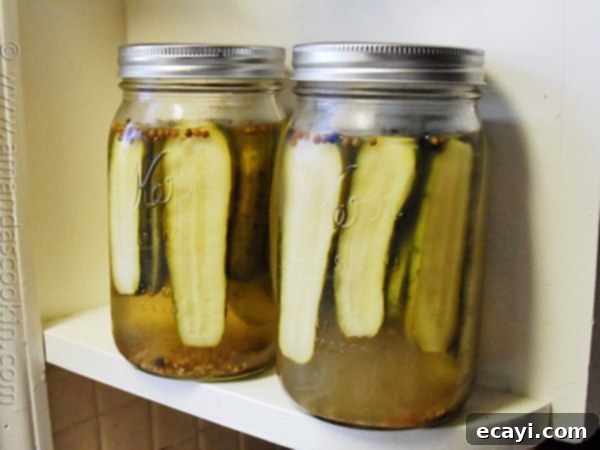
This beloved Claussen pickle recipe was originally published here on September 18, 2012, and has been a favorite ever since!
More Related Recipes You’ll Love
- Refreshing Cucumber Salad
- Vibrant Sweet Corn and Chickpea Salad
- Flavorful Grilled Corn and Zucchini Salad
- Tangy Pickled Beets
- Crisp Pickled Onions
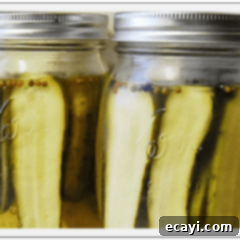
Homemade Claussen Pickles Copycat
IMPORTANT – There are often Frequently Asked Questions within the blog post that you may find helpful. Simply scroll back up to read them!
Print It
Pin It
Rate It
Save ItSaved!
Ingredients
- 20-25 small to medium pickling cucumbers
- 2 quarts cold water
- ½ cup white vinegar
- ⅓ cup canning/pickling salt or coarse Kosher salt
- 1 teaspoon coriander seed
- ½ teaspoon mustard seed
- ¼ teaspoon red pepper flakes
- 1 tablespoon black peppercorns
- 1 tablespoon dill seed
- ¼ teaspoon dried garlic
- Fine mesh colander
- 4- cup measuring cup
- pickle crisper optional
Before You Begin
- A couple of our readers have mentioned using pickle crisper in their mixture which helps prevent the pickles from getting soggy. You can add 1/4 teaspoon of pickle crisper to each quart size jar if desired.
Instructions
-
To make the brine, combine water and vinegar in a large pitcher. Add salt, coriander seed, mustard seed, red pepper flakes and black peppercorns. Stir vigorously until all the salt is completely dissolved, ensuring a uniform brine solution. Set aside.
-
Thoroughly wash your pickling cucumbers under cold running water to remove any dirt or residue. Carefully trim 1/8-inch off of the blossom end of each cucumber, as this end contains an enzyme that can cause softness. For consistent results, consider trimming both ends. Slice each cucumber in half lengthwise to allow for optimal brine penetration and easy packing.
-
Divide the dill seed and dried garlic evenly between two clean, sterilized quart-sized jars. Begin filling the jars with the cucumber halves, packing them as snugly as possible without crushing. A tight fit helps keep the cucumbers submerged and ensures even pickling.
-
Give your brine a final stir to re-mix any settled ingredients. Place a fine mesh colander over a large bowl or measuring cup. Carefully pour the brine through the colander, catching the brine solids (spices) in the colander. It is crucial NOT to discard these flavorful solids!
-
NOTE: You will likely find that the capacity of your measuring cup or even your two jars is less than the total volume of brine prepared. The primary objective of this step is to separate and save the brine solids for even distribution. The excess liquid vinegar and water mixture, once the solids are removed and the jars are filled, can be safely discarded.
-
Once all the flavorful solids have been removed from the brine liquid, distribute them evenly among the two prepared jars. Then, using the strained brine liquid collected in the measuring cup, carefully pour it into the jars until all the cucumber halves are fully covered.
-
Ensure your brine level completely covers the cucumbers and reaches approximately the bottom of the jar neck, where the threading for the lid begins. Remember that the cucumbers will release some of their own liquid during brining, so avoid overfilling the jar. Discard any remaining brine liquid that could not fit into the jars.
-
Cover each jar lightly with its lid, ensuring it is merely “perched” on top and NOT closed and sealed tightly. This allows air to enter and fermentation gases to escape. Leave the jars on your kitchen counter (away from direct sunlight) for 1 day to begin the fermentation process. Following this initial period, transfer them to the refrigerator for an additional 2-3 days, or until the cucumbers have fully absorbed the flavors and taste like delicious, tangy pickles throughout.
-
Once your pickles have reached their desired flavor and texture, securely fasten the lids on the jars. Store these homemade Claussen-style dill pickles in the refrigerator for up to six months, ready to enjoy whenever a craving strikes!
Nutrition Information
The recipes on this blog are tested with a conventional gas oven and gas stovetop. It’s important to note that some ovens, especially as they age, can cook and bake inconsistently. Using an inexpensive oven thermometer can assure you that your oven is truly heating to the proper temperature. If you use a toaster oven or countertop oven, please keep in mind that they may not distribute heat the same as a conventional full sized oven and you may need to adjust your cooking/baking times. In the case of recipes made with a pressure cooker, air fryer, slow cooker, or other appliance, a link to the appliances we use is listed within each respective recipe. For baking recipes where measurements are given by weight, please note that results may not be the same if cups are used instead, and we can’t guarantee success with that method.
